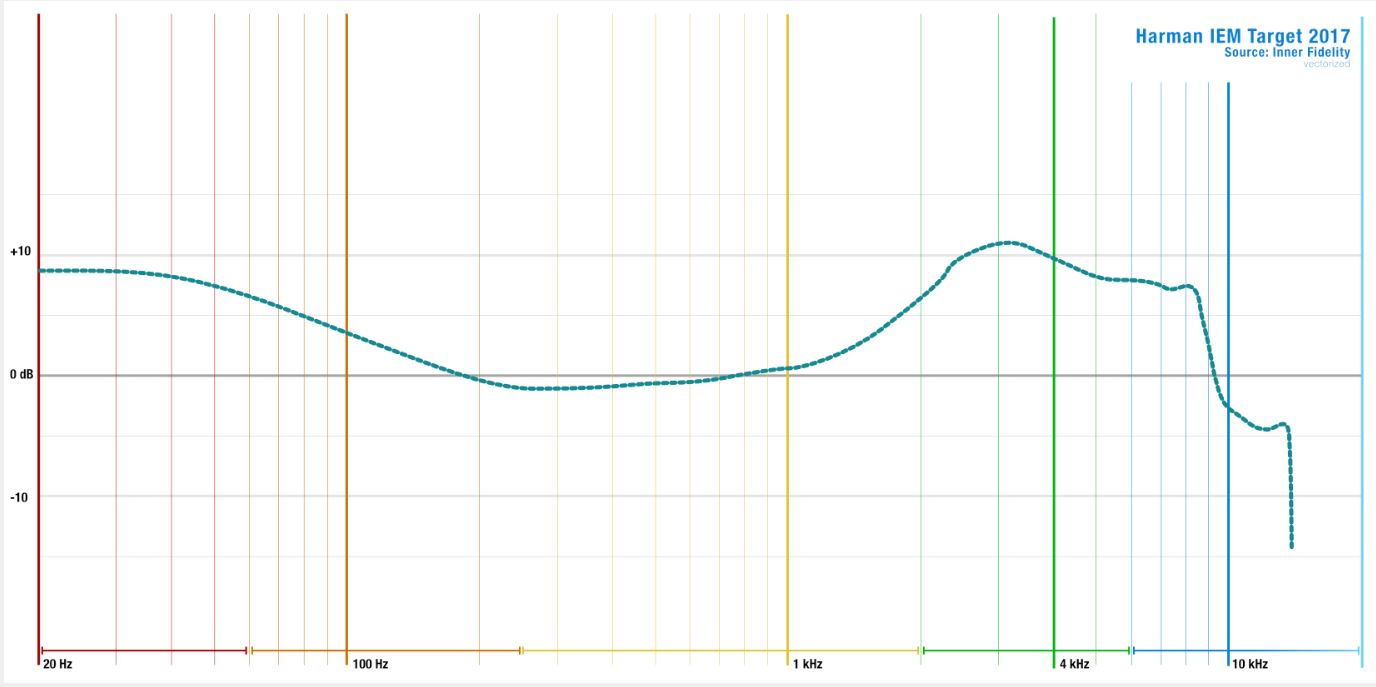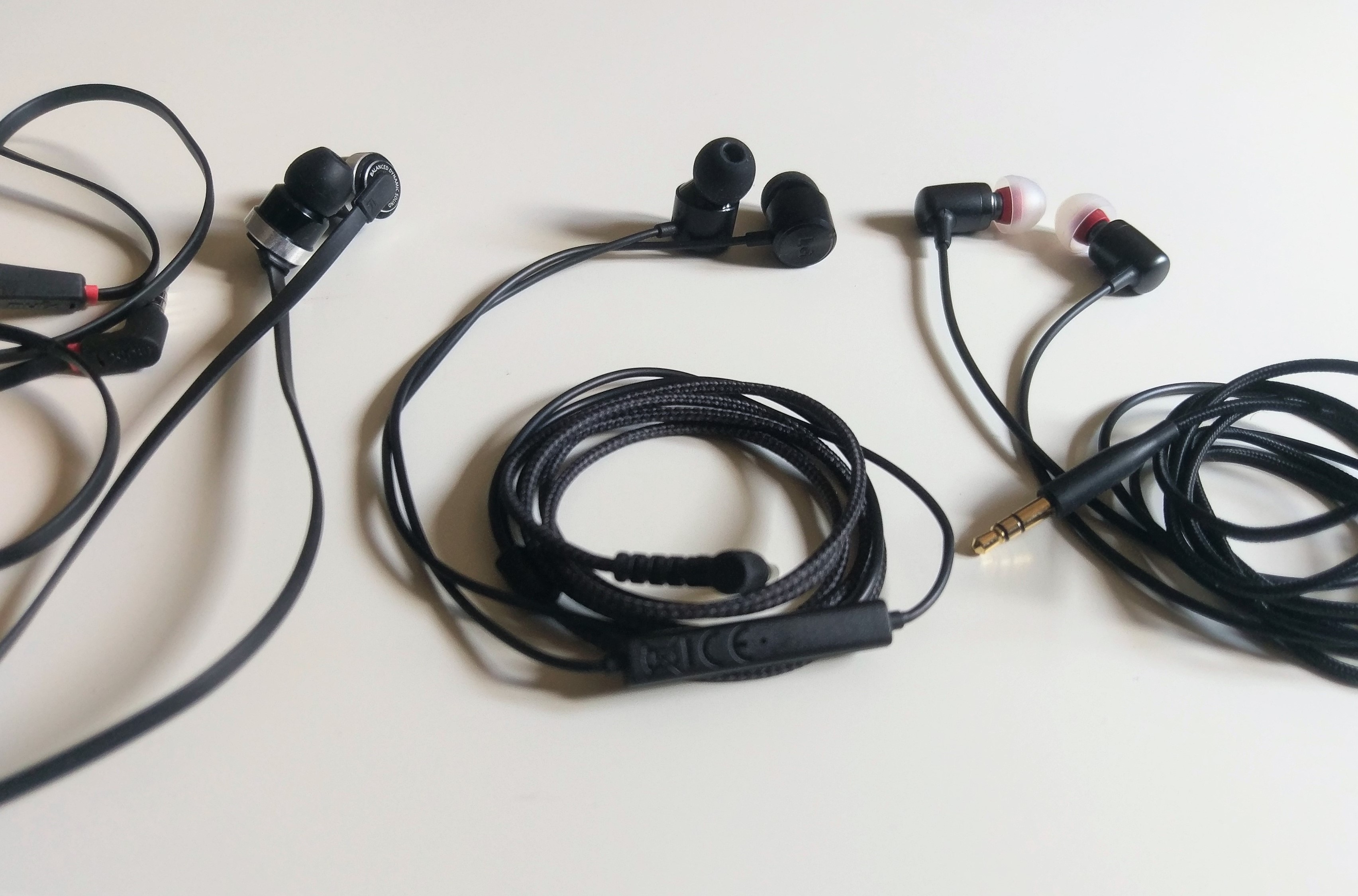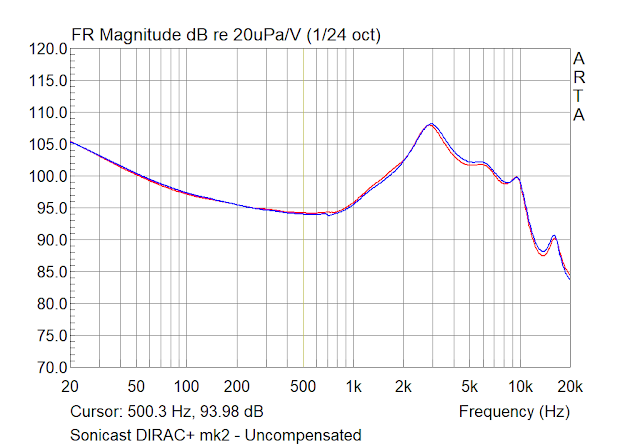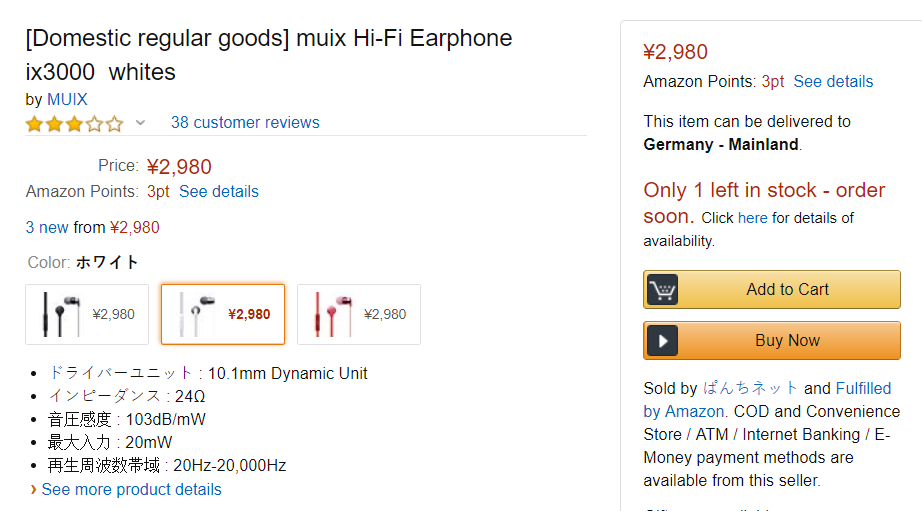I wanted to record my impressions of 3 new IEMs i got recently. I had to buy them to indulge my curiosity and experience some earphones tuned close to the Harman target response.
Anyone who has been dwelling in this hobby for a while must have heard about this famous, often-touted, “Harman” response curve which, arguably, defines the ideal response that should sound balanced to the human ear. In other words, if an earphone is tuned close to this Harman target curve, then they are guaranteed to sound balanced to most of us. I believe the idea was to get the same effect one gets when listening to a good set of speakers.
As we start getting serious about this hobby we get this tendency to drift toward the “neutral” signature. We want uncoloured sound, we like sound as it is recorded, we are not mass-consumers, we don’t like what most of the people like, we are special, we have golden-ears, enhanced bass is bad, and so on.
So, eventually we buy the Etymotic earphones renowned for their neutrality. The ER4SR/PT, for example, is tuned to sound strictly neutral according to their own standards which sits somewhere between the “Free-Field” and “Diffuse-Field” frequency responses.

One is now left in a difficult situation where one must accept that this is the best sound, and as a wannabe audiophile, one embraces this signature and learns to love it. Of course, the mids are treble are incredibly clear with great detail extraction but one cannot deny the wanting bass in the BA models of Etymotics, and a certain lifelessness to the song. (Even Etymotic acknowledges and later condescends to make an XR version with a little nudge in the bass quantity).
I imagine this was how Sean Olive felt, the name behind the Harman-Target response. And so, a good bump of upto 10 dB was introduced in the sub bass regions starting from 200Hz down to 20Hz, with a little adjustment in the lower treble as well.
Behold the Harman target response:

I believe this greatly helped the community to still be “audiophiles” without sacrificing some jolly good sub-bass.
Anyway, this is exactly where I was a couple of months ago when I decided to go on a little shopping spree and got three IEMs which are tuned close to the Harman Target curve. And I would like to drop some impressions and compare these 3 very affordable, good Korean earphones here.
MUIX IX3000 (iSound) Vs QUADBEAT 3 (LG) Vs DIRAC + MK2 (Sonicast)

I picked the measurements of these earphones from @speakerphone's blog: https://clarityfidelity.blogspot.com/
Please visit there to see more graphs of these earphones if interested.
MUIX IX3000 || Price 38 USD incl. import to EU (amazon.co.jp)
Driver: 10.1 mm Single dynamic | Impedance: 24Ω | Sensitivity: 103dB/mW
Build: Solid metal housing with flat non-detachable cable with remote+mic terminating at an L-shaped plug. Very good build.
Accessories: 3 sizes silicon tips, no pouch.
Usage:
They are comfortable for a straight fit. The housings are lightweight. Microphonics are very present. Wear a jacket on top to keep the wires from bouncing. I also notice occasional driver flex while inserting. Not a big deal., but it’s there. Needs 50% volume in my HTC10s
Preferred eartips: Final E tips

Sound: Very balanced sound. They have correct tone and timbre. The sound is smack in the middle of bright and warm. This comes closest to the stereo experience in terms of warmth. Bass is on point, without much bass-bleed, or bloaty feel. The driver is neither fast nor slow. It strikes a good balance between impact and speed. No sibilance, upper-mids are perfectly placed. Male and female voices are treated equally. There is enough warmth in the mix, and weight in the mids. The soundstage also displays decent width, and a bit of height. Not the most resolving, like Co-Donguri, for example, but one wouldn’t call it bad. The tone is just perfect, and hits the sweet spot for me. It sounds full without getting too congested. Not the greatest instrument separation or positioning. Balanced in every sense of the word. Another noteworthy point is that iSound teamed up with goldenears.net to tune this IEM, and this is positively reviewed, obviously, by the goldenears team.
Sonicast Dirac + MK2 || Price 51 USD +10 USD import to EU (amazon.com)
Model: DIRAC-S501R/BK
Driver: 8mm SF driver (Dynamic) | Impedance: 27Ω | Sensitivity: 103dB/mW
Build: Solid metal housings with thin rubber cables until the Y splitter. Braided cloth cable from Y splitter down to the thin straight jack. Mediocre build.
Accessories: Complete with a hard zipper case, 3 Silicon tips, plus 1 pair of foam tips, plus shirt-clip.
Usage:
They are very comfortable. The housings are relatively heavier than the other 2 earphones. Can be worn either way. The housings are sleak and can be inserted farther inside the ear canal (with over ear use). Over the ear wear is preferred to avoid any microphonics. The shirt clip will also prevent any cable noise. Slightly high volume is recommended to squeeze a bit more warmth.
Preferred eartips: SpinFits

Sound: Dirac + MK2s, again, sounds very balanced and correct. Here we notice a slight tilt toward brightness and the upper mids. A little body is missing in the mids, and there is a certain lack of warmth in the male voices. Females get a little egde and come slightly forward. With the ssss and zzzs, we touch closer to sibilance than the more organic IX3000. It's not too much but can be noticed. However, this tuning favours the DIRAC in some ways. The mid bass is faster and the attack is snappier. Bass is cleaner with less fluidity. There is more instrument separation and breathing space for the instruments. Little more details are also extracted. The soundstage also seems to expand further in comparison and shows a bit of depth too. The IX3000 I would say is more accessible and easier to use, they being more organic in tone, than the slightly more clinical delivery of the Dirac + MK2s.
LG Quadbeat 3 || Stock earphones with LG G7
Driver: Single dynamic | Impedance: 24Ω | Sensitivity: 105dB/mW
Build: Solid Aluminium housings with thin rubber cables until the Y splitter. Braided cloth cable from Y splitter down to the L-shaped jack. They have a remote+mic module. Mediocre build.
Accessories: 3 sizes silicon tips, no pouch
Usage:
Semi-open style housing, but the fit is as close as a closed earphone. Great nozzle angle enables an easy seal. Nozzle length is also quite long for an IEM. Most comfortable in the ear compare to the other two. Straight down wear only, and microphonics are quite bad.

Sound: These have the biggest bass of the bunch. There is great impact, which can immediately satisfy the masses. As a result, we can notice a little bleed into the lower mids. However, the voices come out without any trouble. Upper mids are perfectly placed, and females sound right. There is good detail retrieval in the upper mids and treble. Slightly lesser sub-bass would have helped in mid-range and mid-bass clarity. However, I must say they sound, tonally, very good. For an earphones that come with a phone one cannot ask for more.
Between the three, I would say the IX3000 and the Dirac + MK2 are on the next level, due to the LG signature featuring a more enhanced bass. As you can see, all three are tuned close to the harman target and as a result they all sound really balanced.
Between the Dirac + MK2 and the IX3000, I really cannot make my mind up as to which one I prefer more. When I listen to the IX3000s i’m left wanting a little more details and separation. With the Dirac, i’m left missing that perfect tint of warmth and fullness that I get from IX3000. I guess getting a warmer DAP or playing with sources can make the Dirac really shine. I think the Dirac driver has a little more potential in them.
Sound rating:
MUIX IX3000: 8.6/10
Dirac + MK2: 8.5/10
LG Quadbeat 3: 8.1/10
I didn't read much impressions of these earphones. And so, i thought it best to open a new thread here. I will add some comparisons to ER2SE as well soon.
If you had any interesting experiences, or stumbled upon any good IEMs while you were progressing through the Harman passage in your journey, please do drop a note here. I would love to hear all about it.
Cheers! And don't forget music!
Yours truly,
Simple Man.
Anyone who has been dwelling in this hobby for a while must have heard about this famous, often-touted, “Harman” response curve which, arguably, defines the ideal response that should sound balanced to the human ear. In other words, if an earphone is tuned close to this Harman target curve, then they are guaranteed to sound balanced to most of us. I believe the idea was to get the same effect one gets when listening to a good set of speakers.
As we start getting serious about this hobby we get this tendency to drift toward the “neutral” signature. We want uncoloured sound, we like sound as it is recorded, we are not mass-consumers, we don’t like what most of the people like, we are special, we have golden-ears, enhanced bass is bad, and so on.
So, eventually we buy the Etymotic earphones renowned for their neutrality. The ER4SR/PT, for example, is tuned to sound strictly neutral according to their own standards which sits somewhere between the “Free-Field” and “Diffuse-Field” frequency responses.

One is now left in a difficult situation where one must accept that this is the best sound, and as a wannabe audiophile, one embraces this signature and learns to love it. Of course, the mids are treble are incredibly clear with great detail extraction but one cannot deny the wanting bass in the BA models of Etymotics, and a certain lifelessness to the song. (Even Etymotic acknowledges and later condescends to make an XR version with a little nudge in the bass quantity).
I imagine this was how Sean Olive felt, the name behind the Harman-Target response. And so, a good bump of upto 10 dB was introduced in the sub bass regions starting from 200Hz down to 20Hz, with a little adjustment in the lower treble as well.
Behold the Harman target response:

I believe this greatly helped the community to still be “audiophiles” without sacrificing some jolly good sub-bass.
Anyway, this is exactly where I was a couple of months ago when I decided to go on a little shopping spree and got three IEMs which are tuned close to the Harman Target curve. And I would like to drop some impressions and compare these 3 very affordable, good Korean earphones here.
MUIX IX3000 (iSound) Vs QUADBEAT 3 (LG) Vs DIRAC + MK2 (Sonicast)

I picked the measurements of these earphones from @speakerphone's blog: https://clarityfidelity.blogspot.com/
Please visit there to see more graphs of these earphones if interested.
MUIX IX3000 || Price 38 USD incl. import to EU (amazon.co.jp)
Driver: 10.1 mm Single dynamic | Impedance: 24Ω | Sensitivity: 103dB/mW
Build: Solid metal housing with flat non-detachable cable with remote+mic terminating at an L-shaped plug. Very good build.
Accessories: 3 sizes silicon tips, no pouch.
Usage:
They are comfortable for a straight fit. The housings are lightweight. Microphonics are very present. Wear a jacket on top to keep the wires from bouncing. I also notice occasional driver flex while inserting. Not a big deal., but it’s there. Needs 50% volume in my HTC10s
Preferred eartips: Final E tips

Sound: Very balanced sound. They have correct tone and timbre. The sound is smack in the middle of bright and warm. This comes closest to the stereo experience in terms of warmth. Bass is on point, without much bass-bleed, or bloaty feel. The driver is neither fast nor slow. It strikes a good balance between impact and speed. No sibilance, upper-mids are perfectly placed. Male and female voices are treated equally. There is enough warmth in the mix, and weight in the mids. The soundstage also displays decent width, and a bit of height. Not the most resolving, like Co-Donguri, for example, but one wouldn’t call it bad. The tone is just perfect, and hits the sweet spot for me. It sounds full without getting too congested. Not the greatest instrument separation or positioning. Balanced in every sense of the word. Another noteworthy point is that iSound teamed up with goldenears.net to tune this IEM, and this is positively reviewed, obviously, by the goldenears team.
Sonicast Dirac + MK2 || Price 51 USD +10 USD import to EU (amazon.com)
Model: DIRAC-S501R/BK
Driver: 8mm SF driver (Dynamic) | Impedance: 27Ω | Sensitivity: 103dB/mW
Build: Solid metal housings with thin rubber cables until the Y splitter. Braided cloth cable from Y splitter down to the thin straight jack. Mediocre build.
Accessories: Complete with a hard zipper case, 3 Silicon tips, plus 1 pair of foam tips, plus shirt-clip.
Usage:
They are very comfortable. The housings are relatively heavier than the other 2 earphones. Can be worn either way. The housings are sleak and can be inserted farther inside the ear canal (with over ear use). Over the ear wear is preferred to avoid any microphonics. The shirt clip will also prevent any cable noise. Slightly high volume is recommended to squeeze a bit more warmth.
Preferred eartips: SpinFits

Sound: Dirac + MK2s, again, sounds very balanced and correct. Here we notice a slight tilt toward brightness and the upper mids. A little body is missing in the mids, and there is a certain lack of warmth in the male voices. Females get a little egde and come slightly forward. With the ssss and zzzs, we touch closer to sibilance than the more organic IX3000. It's not too much but can be noticed. However, this tuning favours the DIRAC in some ways. The mid bass is faster and the attack is snappier. Bass is cleaner with less fluidity. There is more instrument separation and breathing space for the instruments. Little more details are also extracted. The soundstage also seems to expand further in comparison and shows a bit of depth too. The IX3000 I would say is more accessible and easier to use, they being more organic in tone, than the slightly more clinical delivery of the Dirac + MK2s.
LG Quadbeat 3 || Stock earphones with LG G7
Driver: Single dynamic | Impedance: 24Ω | Sensitivity: 105dB/mW
Build: Solid Aluminium housings with thin rubber cables until the Y splitter. Braided cloth cable from Y splitter down to the L-shaped jack. They have a remote+mic module. Mediocre build.
Accessories: 3 sizes silicon tips, no pouch
Usage:
Semi-open style housing, but the fit is as close as a closed earphone. Great nozzle angle enables an easy seal. Nozzle length is also quite long for an IEM. Most comfortable in the ear compare to the other two. Straight down wear only, and microphonics are quite bad.

Sound: These have the biggest bass of the bunch. There is great impact, which can immediately satisfy the masses. As a result, we can notice a little bleed into the lower mids. However, the voices come out without any trouble. Upper mids are perfectly placed, and females sound right. There is good detail retrieval in the upper mids and treble. Slightly lesser sub-bass would have helped in mid-range and mid-bass clarity. However, I must say they sound, tonally, very good. For an earphones that come with a phone one cannot ask for more.
Between the three, I would say the IX3000 and the Dirac + MK2 are on the next level, due to the LG signature featuring a more enhanced bass. As you can see, all three are tuned close to the harman target and as a result they all sound really balanced.
Between the Dirac + MK2 and the IX3000, I really cannot make my mind up as to which one I prefer more. When I listen to the IX3000s i’m left wanting a little more details and separation. With the Dirac, i’m left missing that perfect tint of warmth and fullness that I get from IX3000. I guess getting a warmer DAP or playing with sources can make the Dirac really shine. I think the Dirac driver has a little more potential in them.
Sound rating:
MUIX IX3000: 8.6/10
Dirac + MK2: 8.5/10
LG Quadbeat 3: 8.1/10
I didn't read much impressions of these earphones. And so, i thought it best to open a new thread here. I will add some comparisons to ER2SE as well soon.
If you had any interesting experiences, or stumbled upon any good IEMs while you were progressing through the Harman passage in your journey, please do drop a note here. I would love to hear all about it.
Cheers! And don't forget music!
Yours truly,
Simple Man.
Last edited:












